[English] 日本語
 Yorodumi
Yorodumi- PDB-5vai: Cryo-EM structure of the activated Glucagon-like peptide-1 recept... -
+ Open data
Open data
- Basic information
Basic information
| Entry | Database: PDB / ID: 5vai | ||||||
|---|---|---|---|---|---|---|---|
| Title | Cryo-EM structure of the activated Glucagon-like peptide-1 receptor in complex with G protein | ||||||
 Components Components |
| ||||||
 Keywords Keywords |  Signaling Protein/Hormone / Signaling Protein/Hormone /  Class B GPCR / Class B GPCR /  GLP-1 / GLP-1R / GLP-1 / GLP-1R /  Complex / Complex /  Signaling Protein-Hormone complex Signaling Protein-Hormone complex | ||||||
| Function / homology |  Function and homology information Function and homology information glucagon receptor binding / glucagon receptor binding /  glucagon receptor activity / G-protein activation / Activation of the phototransduction cascade / : / Glucagon-type ligand receptors / Thromboxane signalling through TP receptor / Sensory perception of sweet, bitter, and umami (glutamate) taste / G beta:gamma signalling through PI3Kgamma / G beta:gamma signalling through CDC42 ... glucagon receptor activity / G-protein activation / Activation of the phototransduction cascade / : / Glucagon-type ligand receptors / Thromboxane signalling through TP receptor / Sensory perception of sweet, bitter, and umami (glutamate) taste / G beta:gamma signalling through PI3Kgamma / G beta:gamma signalling through CDC42 ... glucagon receptor binding / glucagon receptor binding /  glucagon receptor activity / G-protein activation / Activation of the phototransduction cascade / : / Glucagon-type ligand receptors / Thromboxane signalling through TP receptor / Sensory perception of sweet, bitter, and umami (glutamate) taste / G beta:gamma signalling through PI3Kgamma / G beta:gamma signalling through CDC42 / Cooperation of PDCL (PhLP1) and TRiC/CCT in G-protein beta folding / Ca2+ pathway / negative regulation of execution phase of apoptosis / Activation of G protein gated Potassium channels / Synthesis, secretion, and inactivation of Glucagon-like Peptide-1 (GLP-1) / Inhibition of voltage gated Ca2+ channels via Gbeta/gamma subunits / G alpha (z) signalling events / Vasopressin regulates renal water homeostasis via Aquaporins / Glucagon-like Peptide-1 (GLP1) regulates insulin secretion / Adrenaline,noradrenaline inhibits insulin secretion / ADP signalling through P2Y purinoceptor 12 / glucagon receptor activity / G-protein activation / Activation of the phototransduction cascade / : / Glucagon-type ligand receptors / Thromboxane signalling through TP receptor / Sensory perception of sweet, bitter, and umami (glutamate) taste / G beta:gamma signalling through PI3Kgamma / G beta:gamma signalling through CDC42 / Cooperation of PDCL (PhLP1) and TRiC/CCT in G-protein beta folding / Ca2+ pathway / negative regulation of execution phase of apoptosis / Activation of G protein gated Potassium channels / Synthesis, secretion, and inactivation of Glucagon-like Peptide-1 (GLP-1) / Inhibition of voltage gated Ca2+ channels via Gbeta/gamma subunits / G alpha (z) signalling events / Vasopressin regulates renal water homeostasis via Aquaporins / Glucagon-like Peptide-1 (GLP1) regulates insulin secretion / Adrenaline,noradrenaline inhibits insulin secretion / ADP signalling through P2Y purinoceptor 12 /  feeding behavior / G alpha (q) signalling events / G alpha (i) signalling events / Thrombin signalling through proteinase activated receptors (PARs) / Activation of G protein gated Potassium channels / G-protein activation / G beta:gamma signalling through PI3Kgamma / Prostacyclin signalling through prostacyclin receptor / Adrenaline,noradrenaline inhibits insulin secretion / G beta:gamma signalling through PLC beta / ADP signalling through P2Y purinoceptor 1 / Thromboxane signalling through TP receptor / Presynaptic function of Kainate receptors / G beta:gamma signalling through CDC42 / Inhibition of voltage gated Ca2+ channels via Gbeta/gamma subunits / Glucagon-type ligand receptors / feeding behavior / G alpha (q) signalling events / G alpha (i) signalling events / Thrombin signalling through proteinase activated receptors (PARs) / Activation of G protein gated Potassium channels / G-protein activation / G beta:gamma signalling through PI3Kgamma / Prostacyclin signalling through prostacyclin receptor / Adrenaline,noradrenaline inhibits insulin secretion / G beta:gamma signalling through PLC beta / ADP signalling through P2Y purinoceptor 1 / Thromboxane signalling through TP receptor / Presynaptic function of Kainate receptors / G beta:gamma signalling through CDC42 / Inhibition of voltage gated Ca2+ channels via Gbeta/gamma subunits / Glucagon-type ligand receptors /  alkylglycerophosphoethanolamine phosphodiesterase activity / G alpha (12/13) signalling events / G beta:gamma signalling through BTK / ADP signalling through P2Y purinoceptor 12 / : / Cooperation of PDCL (PhLP1) and TRiC/CCT in G-protein beta folding / Thrombin signalling through proteinase activated receptors (PARs) / Ca2+ pathway / Extra-nuclear estrogen signaling / G alpha (z) signalling events / G alpha (s) signalling events / G alpha (q) signalling events / photoreceptor outer segment membrane / G alpha (i) signalling events / Glucagon-like Peptide-1 (GLP1) regulates insulin secretion / alkylglycerophosphoethanolamine phosphodiesterase activity / G alpha (12/13) signalling events / G beta:gamma signalling through BTK / ADP signalling through P2Y purinoceptor 12 / : / Cooperation of PDCL (PhLP1) and TRiC/CCT in G-protein beta folding / Thrombin signalling through proteinase activated receptors (PARs) / Ca2+ pathway / Extra-nuclear estrogen signaling / G alpha (z) signalling events / G alpha (s) signalling events / G alpha (q) signalling events / photoreceptor outer segment membrane / G alpha (i) signalling events / Glucagon-like Peptide-1 (GLP1) regulates insulin secretion /  spectrin binding / Vasopressin regulates renal water homeostasis via Aquaporins / positive regulation of calcium ion import / cellular response to glucagon stimulus / positive regulation of insulin secretion involved in cellular response to glucose stimulus / PKA activation in glucagon signalling / regulation of insulin secretion / hair follicle placode formation / spectrin binding / Vasopressin regulates renal water homeostasis via Aquaporins / positive regulation of calcium ion import / cellular response to glucagon stimulus / positive regulation of insulin secretion involved in cellular response to glucose stimulus / PKA activation in glucagon signalling / regulation of insulin secretion / hair follicle placode formation /  intracellular transport / photoreceptor outer segment / intracellular transport / photoreceptor outer segment /  D1 dopamine receptor binding / developmental growth / Synthesis, secretion, and deacylation of Ghrelin / Hedgehog 'off' state / positive regulation of cAMP-mediated signaling / adenylate cyclase-activating adrenergic receptor signaling pathway / protein kinase A signaling / positive regulation of gluconeogenesis / cardiac muscle cell apoptotic process / activation of adenylate cyclase activity / photoreceptor inner segment / adenylate cyclase activator activity / response to activity / trans-Golgi network membrane / positive regulation of peptidyl-threonine phosphorylation / D1 dopamine receptor binding / developmental growth / Synthesis, secretion, and deacylation of Ghrelin / Hedgehog 'off' state / positive regulation of cAMP-mediated signaling / adenylate cyclase-activating adrenergic receptor signaling pathway / protein kinase A signaling / positive regulation of gluconeogenesis / cardiac muscle cell apoptotic process / activation of adenylate cyclase activity / photoreceptor inner segment / adenylate cyclase activator activity / response to activity / trans-Golgi network membrane / positive regulation of peptidyl-threonine phosphorylation /  gluconeogenesis / G-protein beta/gamma-subunit complex binding / adenylate cyclase-modulating G protein-coupled receptor signaling pathway / gluconeogenesis / G-protein beta/gamma-subunit complex binding / adenylate cyclase-modulating G protein-coupled receptor signaling pathway /  bone development / Prostacyclin signalling through prostacyclin receptor / Glucagon signaling in metabolic regulation / adenylate cyclase-activating G protein-coupled receptor signaling pathway / bone development / Prostacyclin signalling through prostacyclin receptor / Glucagon signaling in metabolic regulation / adenylate cyclase-activating G protein-coupled receptor signaling pathway /  hormone activity / Synthesis, secretion, and inactivation of Glucagon-like Peptide-1 (GLP-1) / hormone activity / Synthesis, secretion, and inactivation of Glucagon-like Peptide-1 (GLP-1) /  platelet aggregation / Glucagon-type ligand receptors / platelet aggregation / Glucagon-type ligand receptors /  cognition / Vasopressin regulates renal water homeostasis via Aquaporins / G alpha (z) signalling events / positive regulation of GTPase activity / cellular response to catecholamine stimulus / Glucagon-like Peptide-1 (GLP1) regulates insulin secretion / ADORA2B mediated anti-inflammatory cytokines production / adenylate cyclase-activating dopamine receptor signaling pathway / cellular response to prostaglandin E stimulus / sensory perception of taste / GPER1 signaling / G-protein beta-subunit binding cognition / Vasopressin regulates renal water homeostasis via Aquaporins / G alpha (z) signalling events / positive regulation of GTPase activity / cellular response to catecholamine stimulus / Glucagon-like Peptide-1 (GLP1) regulates insulin secretion / ADORA2B mediated anti-inflammatory cytokines production / adenylate cyclase-activating dopamine receptor signaling pathway / cellular response to prostaglandin E stimulus / sensory perception of taste / GPER1 signaling / G-protein beta-subunit bindingSimilarity search - Function | ||||||
| Biological species |   Oryctolagus cuniculus (rabbit) Oryctolagus cuniculus (rabbit)  Homo sapiens (human) Homo sapiens (human)  Rattus norvegicus (Norway rat) Rattus norvegicus (Norway rat)  Bos taurus (cattle) Bos taurus (cattle)  Lama glama (llama) Lama glama (llama) | ||||||
| Method |  ELECTRON MICROSCOPY / ELECTRON MICROSCOPY /  single particle reconstruction / single particle reconstruction /  cryo EM / Resolution: 4.1 Å cryo EM / Resolution: 4.1 Å | ||||||
 Authors Authors | Zhang, Y. / Sun, B. / Feng, D. / Hu, H. / Chu, M. / Qu, Q. / Tarrasch, J.T. / Li, S. / Kobilka, T.S. / Kobilka, B.K. / Skiniotis, G. | ||||||
 Citation Citation |  Journal: Nature / Year: 2017 Journal: Nature / Year: 2017Title: Cryo-EM structure of the activated GLP-1 receptor in complex with a G protein. Authors: Yan Zhang / Bingfa Sun / Dan Feng / Hongli Hu / Matthew Chu / Qianhui Qu / Jeffrey T Tarrasch / Shane Li / Tong Sun Kobilka / Brian K Kobilka / Georgios Skiniotis /  Abstract: Glucagon-like peptide 1 (GLP-1) is a hormone with essential roles in regulating insulin secretion, carbohydrate metabolism and appetite. GLP-1 effects are mediated through binding to the GLP-1 ...Glucagon-like peptide 1 (GLP-1) is a hormone with essential roles in regulating insulin secretion, carbohydrate metabolism and appetite. GLP-1 effects are mediated through binding to the GLP-1 receptor (GLP-1R), a class B G-protein-coupled receptor (GPCR) that signals primarily through the stimulatory G protein G. Class B GPCRs are important therapeutic targets; however, our understanding of their mechanism of action is limited by the lack of structural information on activated and full-length receptors. Here we report the cryo-electron microscopy structure of the peptide-activated GLP-1R-G complex at near atomic resolution. The peptide is clasped between the N-terminal domain and the transmembrane core of the receptor, and further stabilized by extracellular loops. Conformational changes in the transmembrane domain result in a sharp kink in the middle of transmembrane helix 6, which pivots its intracellular half outward to accommodate the α5-helix of the Ras-like domain of G. These results provide a structural framework for understanding class B GPCR activation through hormone binding. | ||||||
| History |
|
- Structure visualization
Structure visualization
| Movie |
 Movie viewer Movie viewer |
|---|---|
| Structure viewer | Molecule:  Molmil Molmil Jmol/JSmol Jmol/JSmol |
- Downloads & links
Downloads & links
- Download
Download
| PDBx/mmCIF format |  5vai.cif.gz 5vai.cif.gz | 218.9 KB | Display |  PDBx/mmCIF format PDBx/mmCIF format |
|---|---|---|---|---|
| PDB format |  pdb5vai.ent.gz pdb5vai.ent.gz | 172.2 KB | Display |  PDB format PDB format |
| PDBx/mmJSON format |  5vai.json.gz 5vai.json.gz | Tree view |  PDBx/mmJSON format PDBx/mmJSON format | |
| Others |  Other downloads Other downloads |
-Validation report
| Arichive directory |  https://data.pdbj.org/pub/pdb/validation_reports/va/5vai https://data.pdbj.org/pub/pdb/validation_reports/va/5vai ftp://data.pdbj.org/pub/pdb/validation_reports/va/5vai ftp://data.pdbj.org/pub/pdb/validation_reports/va/5vai | HTTPS FTP |
|---|
-Related structure data
| Related structure data |  8653MC M: map data used to model this data C: citing same article ( |
|---|---|
| Similar structure data |
- Links
Links
- Assembly
Assembly
| Deposited unit | 
|
|---|---|
| 1 |
|
- Components
Components
-Guanine nucleotide-binding protein ... , 3 types, 3 molecules ABG
| #3: Protein | Mass: 44370.168 Da / Num. of mol.: 1 / Fragment: UNP residuews 1-380 Source method: isolated from a genetically manipulated source Source: (gene. exp.)   Homo sapiens (human) / Gene: GNAS, GNAS1, GSP / Production host: Homo sapiens (human) / Gene: GNAS, GNAS1, GSP / Production host:   Trichoplusia ni (cabbage looper) / References: UniProt: P63092 Trichoplusia ni (cabbage looper) / References: UniProt: P63092 |
|---|---|
| #4: Protein | Mass: 38744.371 Da / Num. of mol.: 1 Source method: isolated from a genetically manipulated source Source: (gene. exp.)   Rattus norvegicus (Norway rat) / Gene: Gnb1 / Production host: Rattus norvegicus (Norway rat) / Gene: Gnb1 / Production host:   Trichoplusia ni (cabbage looper) / References: UniProt: P54311 Trichoplusia ni (cabbage looper) / References: UniProt: P54311 |
| #5: Protein | Mass: 7563.750 Da / Num. of mol.: 1 / Fragment: UNP residues 1-68 Source method: isolated from a genetically manipulated source Source: (gene. exp.)   Bos taurus (cattle) / Gene: GNG2 / Production host: Bos taurus (cattle) / Gene: GNG2 / Production host:   Trichoplusia ni (cabbage looper) / References: UniProt: P63212 Trichoplusia ni (cabbage looper) / References: UniProt: P63212 |
-Protein / Protein/peptide / Antibody , 3 types, 3 molecules RPN
| #1: Protein | Mass: 52581.793 Da / Num. of mol.: 1 Source method: isolated from a genetically manipulated source Source: (gene. exp.)   Oryctolagus cuniculus (rabbit) / Gene: GLP1R / Production host: Oryctolagus cuniculus (rabbit) / Gene: GLP1R / Production host:   Spodoptera frugiperda (fall armyworm) / References: UniProt: G1SGD4 Spodoptera frugiperda (fall armyworm) / References: UniProt: G1SGD4 |
|---|---|
| #2: Protein/peptide |  Glucagon-like peptide-1 Glucagon-like peptide-1Mass: 3359.699 Da / Num. of mol.: 1 / Fragment: UNP residues 98-128 / Source method: obtained synthetically / Source: (synth.)   Homo sapiens (human) / References: UniProt: P01275 Homo sapiens (human) / References: UniProt: P01275 |
| #6: Antibody |  Single-domain antibody Single-domain antibodyMass: 15140.742 Da / Num. of mol.: 1 Source method: isolated from a genetically manipulated source Source: (gene. exp.)   Lama glama (llama) / Production host: Lama glama (llama) / Production host:   Escherichia coli (E. coli) Escherichia coli (E. coli) |
-Experimental details
-Experiment
| Experiment | Method:  ELECTRON MICROSCOPY ELECTRON MICROSCOPY |
|---|---|
| EM experiment | Aggregation state: PARTICLE / 3D reconstruction method:  single particle reconstruction single particle reconstruction |
- Sample preparation
Sample preparation
| Component | Name: the activated glucagon-like peptide-1 receptor in complex with the heterotrimeric Gs protein Type: COMPLEX / Entity ID: all / Source: RECOMBINANT |
|---|---|
| Molecular weight | Value: 0.15 MDa / Experimental value: NO |
| Source (natural) | Organism:   Oryctolagus cuniculus (rabbit) Oryctolagus cuniculus (rabbit) |
| Source (recombinant) | Organism:   Spodoptera frugiperda (fall armyworm) Spodoptera frugiperda (fall armyworm) |
| Buffer solution | pH: 7.5 |
| Specimen | Conc.: 1 mg/ml / Embedding applied: NO / Shadowing applied: NO / Staining applied : NO / Vitrification applied : NO / Vitrification applied : YES : YES |
| Specimen support | Grid type: Quantifoil |
Vitrification | Instrument: FEI VITROBOT MARK IV / Cryogen name: ETHANE / Humidity: 100 % |
- Electron microscopy imaging
Electron microscopy imaging
| Experimental equipment |  Model: Titan Krios / Image courtesy: FEI Company |
|---|---|
| Microscopy | Model: FEI TITAN KRIOS |
| Electron gun | Electron source : :  FIELD EMISSION GUN / Accelerating voltage: 300 kV / Illumination mode: FLOOD BEAM FIELD EMISSION GUN / Accelerating voltage: 300 kV / Illumination mode: FLOOD BEAM |
| Electron lens | Mode: BRIGHT FIELD Bright-field microscopy / Nominal magnification: 29000 X / Calibrated magnification: 50000 X / Alignment procedure: COMA FREE Bright-field microscopy / Nominal magnification: 29000 X / Calibrated magnification: 50000 X / Alignment procedure: COMA FREE |
| Specimen holder | Cryogen: NITROGEN / Specimen holder model: FEI TITAN KRIOS AUTOGRID HOLDER |
| Image recording | Electron dose: 90 e/Å2 / Detector mode: COUNTING / Film or detector model: GATAN K2 SUMMIT (4k x 4k) |
- Processing
Processing
| Software | Name: PHENIX / Version: 1.11.1_2575: / Classification: refinement | ||||||||||||||||||||||||
|---|---|---|---|---|---|---|---|---|---|---|---|---|---|---|---|---|---|---|---|---|---|---|---|---|---|
| EM software |
| ||||||||||||||||||||||||
CTF correction | Type: PHASE FLIPPING AND AMPLITUDE CORRECTION | ||||||||||||||||||||||||
| Symmetry | Point symmetry : C1 (asymmetric) : C1 (asymmetric) | ||||||||||||||||||||||||
3D reconstruction | Resolution: 4.1 Å / Resolution method: FSC 0.143 CUT-OFF / Num. of particles: 139299 / Algorithm: BACK PROJECTION / Num. of class averages: 1 / Symmetry type: POINT | ||||||||||||||||||||||||
| Refine LS restraints |
|
 Movie
Movie Controller
Controller


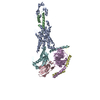

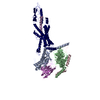
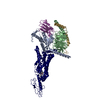



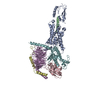
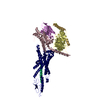
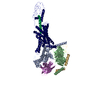
 PDBj
PDBj






















